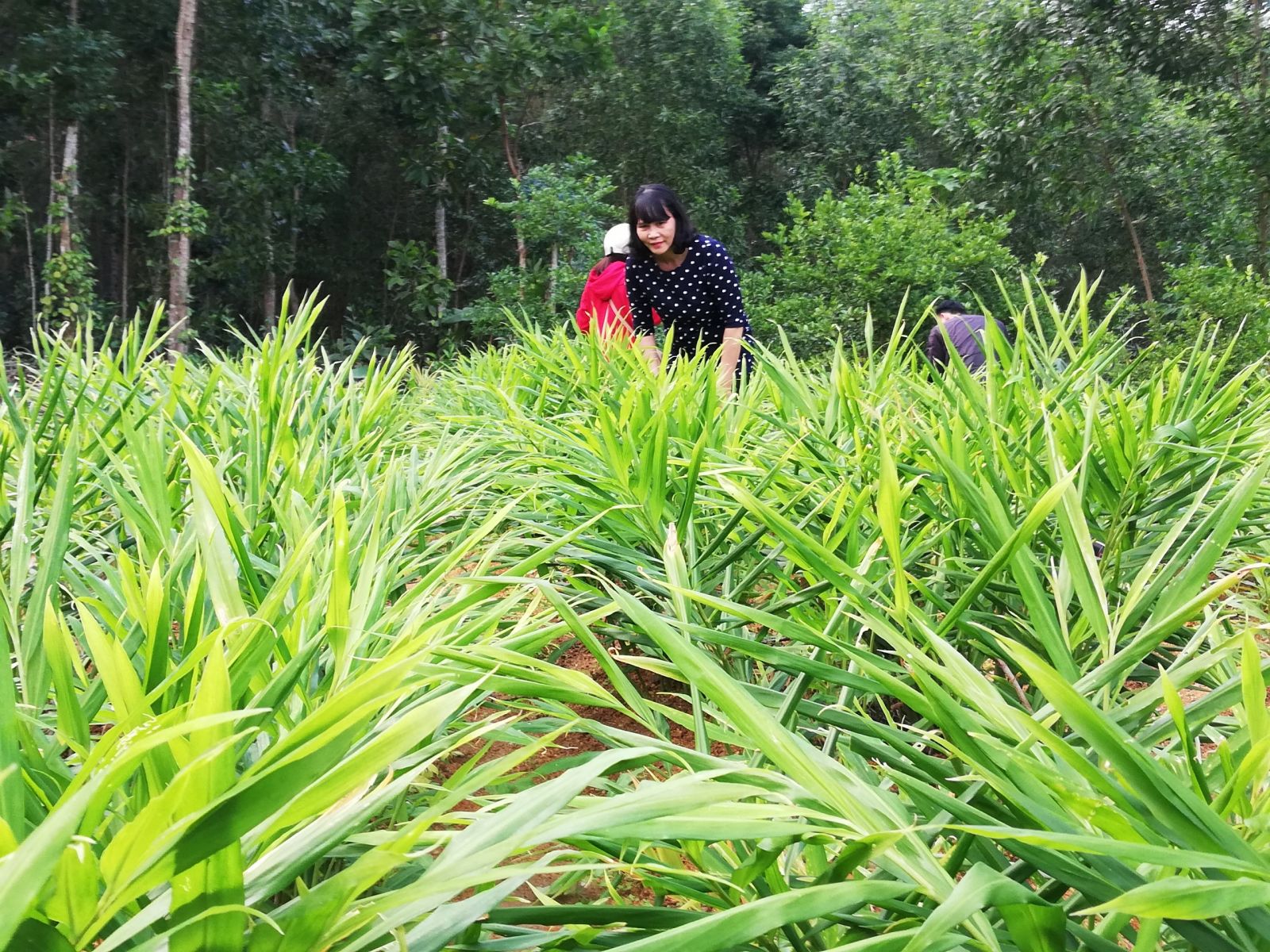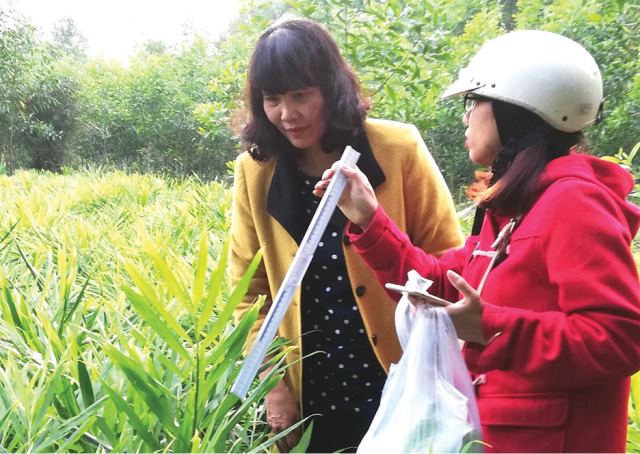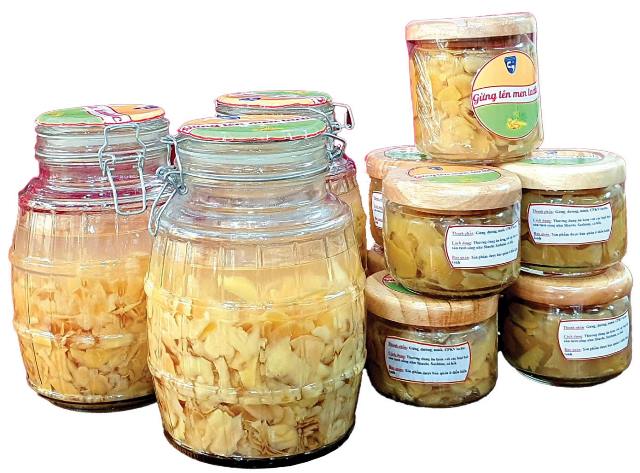
Hue ginger variety developed well
Can't lose the Hue ginger variety
Assoc. Prof. Phuong shared, “The idea ofresearching Hue ginger originated from a group member's story about Gari ginger, a Japanese pickle made from fresh ginger that is very popular despite its rather expensive price (210,000 VND/kg), used as an accompaniment in sushi and sashimi dishes. Thua Thien Hue is very famous for its fresh ginger and Hue ginger jam specialties; however, the area of ginger growing space has decreased gradually over the years. The question of how to preserve this precious genetic resource and develop Hue-branded ginger in a sustainable way has become the driving force for our research team.”
Although Hue ginger has a special aroma and pungent taste, the yield is not high due to the small size of Hue ginger. In fact, it is difficult for Hue ginger to compete on price with the large beautiful imported buffalo ginger variety, leading to the fact that Hue ginger-grown area being gradually shrunk. Instead, people in some regions started to grow imported varieties of ginger with larger bulbs and higher yields. Finished products sold in markets and supermarkets are mainly made from these types of ginger.
For the last two years, due to the influence of the COVID-19 pandemic, ginger could not be imported. Therefore, high quality Hue ginger was chosen by many users for disease prevention, so the price of ginger increased to 50,000 - 70,000 VND per kilo. However, people do not have bulbs to plant and have to invest in buying higher-priced variety.
“The identification of perennial ginger "varieties" in Hue for cultivation or production is mainly based on formal characteristics such as the size of the tubers, aroma, spiciness, and composition of essential oils. However, these formal features are unstable and dependent on environmental conditions, which can make the classification inaccurate. This makes the identification of the original ginger "variety" of Thua Thien Hue by formal characteristics increasingly ambiguous, leading to the risk of losing the characteristic "Hue ginger variety" that has long been grown in Thua Thien Hue," Assoc. Prof. Phuong worried.
This is the reason why she and the research team decided to carry out the project named "Identifying Hue ginger and solutions to develop it in Thua Thien Hue".
Can’t sleep or eat
In August 2018, the research team collected samples and contacted Mr. Le Chuong, an farmer with decades of experience in growing ginger in Tuan for trial planting. Simultaneously, they also conducted molecular biology research in the laboratory and researched technical solutions to grow ginger and processed fermented ginger in two consecutive seasons: 2019-2020 and 2020-2021.

Assoc. Prof. Phuong (yellow shirt) and her partners visited the ginger garden
It is difficult to tell all the difficulties that Assoc. Prof. Phuong and her colleagues have encountered for three years of researching to preserve and retain the typical Hue ginger variety. The biggest obstacle to mention is the unfavorable weather.
Although the 2018-2019 and 2019-2020 ginger crops experienced a prolonged drought, which greatly affected the sowing time and germination of ginger bulb. However, through research, the team succeeded in identifying suitable technical solutions, thereby building a process of growing ginger with high yield, reducing the rate of pests and diseases in Thuy Bieu and Huong Tho lands.
The group also built model of growing ginger with inoculant treatment for not only high germination rate and yield but also with large, beautiful ginger bulbs with economic efficiency increasing by more than 24%.
In the 2020-2021 ginger crop, after more than a month of planting, Thua Thien Hue continuously suffered from storms and floods, causing a lot of ginger area to be damaged. The ginger growing areas of the local people also faced the same situation. The research team faced the risk of no longer having bulbs.
“Witnessing the effort spent drifting with the flood water in some areas made us so worried and impatient that we barely ate or slept. There were some days when the flood began to recede, everyone waded to the field to find a solution since we had to harvest the ginger otherwise, we would lose the variety. Many households now no longer have the variety to plant,” told Assoc. Prof Phuong.
The difficulties were not over. After the flood receded, the disease appeared on the remaining ginger growing area. The disease spread quickly, causing rot and mass death of plants. The enthusiasm of the whole research team for several years could not go down the drain, so everyone tried to overcome the difficulties.
“Thanks to choosing the standard ginger variety and having solutions to treat the bulbs with probiotics and appropriate technical solutions, the disease has been limited and overcome. We can still harvest ginger root in this season to provide raw materials for processing and seeding in the next season”, recalled Assoc. Prof. Phuong.
Flourishing
Finally, the "fruition" has come after three years. Based on investigating the situation of ginger production in more than 300 ginger-growing households in Thua Thien Hue, the research team has built a data set and identified the correct Hue ginger variety using molecular techniques (results have been registered on the GenBank including 41 sequences of barcoded DNA fragments of ginger).
The research team also applied plant propagation by tissue culture to provide seedlings for production. Besides, they also identified technical measures to grow ginger with the aim of increasing ginger yield and reducing the rate of harmful pests and diseases.
From the research results, the plan of growing ginger for Thuy Bieu and Huong Tho has been formed, helping the development of Hue ginger variety in the near future become favorable, solving the current difficulties in ginger production.

Lactic-fermented ginger product has its own spicy taste of Hue ginger
There is another product made from Hue ginger being produced. Through the research and processing of fermented ginger products, Assoc. Prof. Phuong and the research team have formed a lactic fermentation process for good quality ginger products, bringing the unique spicy taste of Hue ginger.
“Currently, the research team is continuing to pave a new way to evaluate the breeding ability of ginger microtubules (the first-generation ginger of the ginger plant in vitro), creating output for growers by diversify processed products and will continue to study to determine the geographical indication for Hue ginger variety. The research team hopes that Hue ginger will be more widely known by domestic and international consumers. Particularly, they will remember not only the Hue flavor in the ginger jam on Tet holiday, but also the sour ginger product bearing the Hue brand," said Assoc. Prof Phuong.
Story: Ngoc Ha
Photo: Provided by the characters in the story
